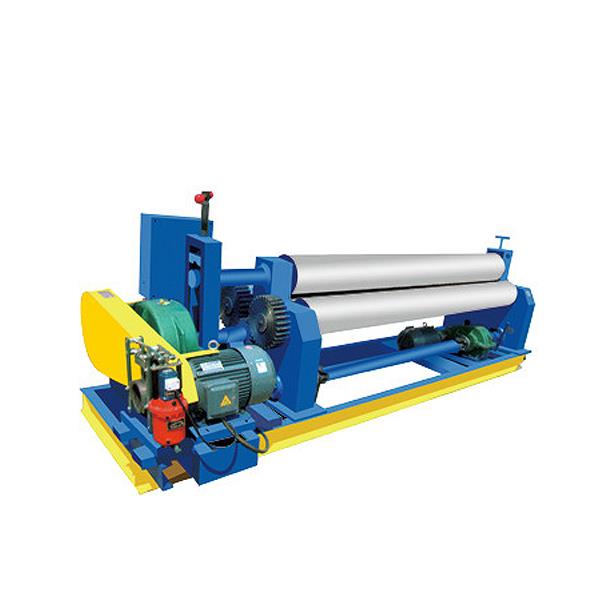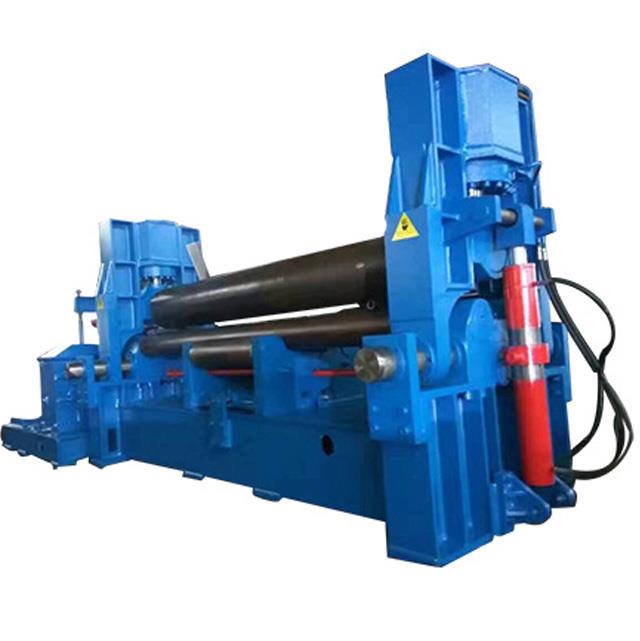Overview of Three-Roll Plate Rolling Machines
Release Time : 2024-10-15 View Count : 次A three-roll plate rolling machine is an essential piece of metal processing equipment designed to bend metal plates into various forms, including cylinders, cones, and spheres. Operating on the principle of three points forming a circle, this machine utilizes the movements of the rollers to induce continuous plastic deformation in the plate, transforming it into the desired shape. Its design allows for efficient shaping of materials while minimizing waste, making it an invaluable tool in many manufacturing processes.
Machine Components

Machine Components


The structure of a three-roll plate rolling machine typically comprises several key components: a sturdy frame, a roller shaft, a transmission system, and a control system. The frame provides stability and support during operation, while the roller shaft houses the rollers that perform the bending. The transmission system transmits power from the motor to the rollers, enabling them to move with precision. Finally, the control system allows for the regulation of the machine's functions, ensuring accurate operation and safety. Depending on the specific requirements and materials used, the machine's specifications can be customized to optimize performance and efficiency.
Industry Applications

Industry Applications


Three-roll plate rolling machines find extensive applications across various industries. In metal processing, they are crucial for shaping pipes, cylinders, and other configurations. Industries such as shipbuilding and aerospace rely on these machines to produce components that require high precision and strength. Additionally, they play a vital role in steel structure engineering, where large plates need to be formed into complex shapes. Beyond these sectors, three-roll plate rolling machines are also used in furniture manufacturing for creating curved components and in automobile manufacturing for producing body panels and other parts. Their versatility makes them a preferred choice in many manufacturing environments.
Key Selection Criteria

Key Selection Criteria


Selecting the appropriate three-roll plate rolling machine involves a careful assessment of several important factors. First, it is crucial to consider the characteristics of the material being processed, including its hardness, strength, and plasticity. Different materials may require different machines to achieve the desired results. The required size and shape of the final product will dictate the necessary roller diameter and gap adjustment capabilities. Additionally, production efficiency should align with expected output levels, ensuring that the machine meets manufacturing demands. Lastly, budget considerations play a role in selecting a machine that balances quality with cost-effectiveness, including potential maintenance needs.
Safety Measures

Safety Measures


Safety is paramount when operating a three-roll plate rolling machine. Before starting any operation, a comprehensive safety inspection should be conducted to ensure that all components are functioning correctly and securely. Operators must wear appropriate protective equipment, including safety glasses and gloves, to shield against potential hazards such as flying metal fragments. During operation, it is essential to maintain the machine's stability to ensure precise bending and prevent accidents. After completing any task, the machine should be thoroughly cleaned to remove metal debris and prevent malfunctions caused by accumulation.
Operating and Maintenance Guidelines
Operating and Maintenance Guidelines


To enhance the performance and longevity of a three-roll plate rolling machine, it is essential to adhere to established operating procedures. Regular lubrication of motor bearings is vital for smooth operation, while routine checks of electrical components help ensure optimal functioning. Lubricating oil should be applied at designated intervals and locations before each operation to maintain efficiency. Additionally, it is important to inspect and replace worn parts, such as V-belts and buttons, in a timely manner. Only trained personnel should operate the machine to minimize the risk of accidents and ensure effective use.
Common Parts Vulnerabilities
Common Parts Vulnerabilities


Despite their sturdy construction, certain components of three-roll plate rolling machines are susceptible to wear and damage over time. The motor may experience burnout due to extended use, and improper handling can lead to damage in the reducer, which may produce excessive noise. Bearings and bearing seats, along with sensitive control system parts, are often among the most frequently worn components. Transmission parts such as lead screws, worms, and nuts are subject to significant friction and may deteriorate with regular use. Composite sleeves, while made from wear-resistant materials, can also suffer wear from continual contact during operation.
Invitation to Order
Invitation to Order


If you require a dependable and high-quality three-roll plate rolling machine, we invite you to place an order with us. Our company offers customized solutions tailored to meet your specific needs, ensuring optimal performance for your applications. With over ten years of industry experience, we provide our customers with a one-year warranty and exceptional support. Reach out to us today for more information and to place your order, and let us help you enhance your manufacturing capabilities with our state-of-the-art equipment.











